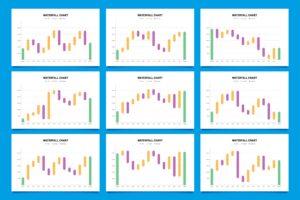Support and resistance are vital tools for traders aiming to predict price movements effectively. They serve as critical levels on price charts where buying or selling pressure emerges, shaping market trends. Mastering support and resistance can significantly improve your trading strategy and help you achieve consistent results.
Table of Contents
This article delves deeply into support and resistance to explain how they work, how to identify them, and how to use them effectively in trading.
What Are Support and Resistance?
They are price levels where market forces tend to halt or reverse price movements. They act as psychological barriers influenced by supply and demand.
Support
Support is a price level where buyers step in, preventing further price declines. It represents demand strength and often signals a potential reversal in an otherwise downward trend.
Resistance
Resistance is a price level where sellers dominate, stopping price increases. It reflects supply strength and indicates where a rally might slow or reverse.
Recognizing them allows traders to predict future price behavior, helping them make informed decisions.
Why Are Support and Resistance Important?
1. Identify Key Price Levels
Support and resistance levels highlight critical price zones where markets often react. These levels can indicate potential turning points in a trend.
2. Enhance Risk Management
By identifying these levels, traders can set effective stop-loss and take-profit orders. This minimizes losses and maximizes gains.
3. Plan Entry and Exit Strategies
Understanding them enables traders to time their trades. Buying near support or selling near resistance improves profitability.
Types of Support and Resistance
Support and resistance levels can vary depending on how they are formed. Here are the primary types:
1. Horizontal Support and Resistance
Horizontal levels occur when the price consistently reacts at the same level. These are the most common and reliable.
2. Trendline Support and Resistance
Trendlines connect consecutive highs or lows, forming dynamic support or resistance. They indicate market trends over time.
3. Moving Average Support and Resistance
Moving averages act as floating levels that adjust with price movements. They provide dynamic guidance in trending markets.
4. Psychological Levels
Round numbers like 1.000 or 10,000 often act as psychological support or resistance. Traders frequently place orders around these levels.
Also Read: Fundamental Analysis
How to Identify Support and Resistance Levels
Identifying them requires careful observation and the use of tools. Here are some techniques:
1. Historical Price Data
Analyze past price movements to find levels where reversals occurred. Consistently recurring levels are strong indicators of support or resistance.
2. Candlestick Patterns
Certain patterns, like hammers or shooting stars, signal potential reversals near support or resistance levels.
3. Technical Indicators
Indicators like Fibonacci retracement, pivot points, and Bollinger Bands help identify key levels.
4. Volume Analysis
High trading volume at a specific price level often validates the strength of support or resistance.
Strategies for Using Support and Resistance in Trading
Once you identify them, you can use them to refine your trading strategies. Here are the most effective methods:
1. Range Trading
2. Breakout Trading
3. Pullback Trading
4. Combining Indicators
Using oscillators like RSI or MACD alongside support and resistance provides additional confirmation. For instance, an overbought RSI near resistance strengthens the likelihood of a reversal.
Also Read: Technical Analysis
Common Mistakes to Avoid
Understanding them is crucial, but traders often make mistakes. Avoid these pitfalls:
1. Ignoring Trends
Support and resistance levels are more reliable when aligned with the prevailing trend. Always consider the broader market direction.
2. Overtrading
Placing trades at every identified level can lead to unnecessary losses. Focus on high-probability setups.
3. Lack of Confirmation
Entering trades without confirming the strength of support or resistance increases risk. Use multiple tools for validation.
4. Chasing Breakouts
Breakouts can be false. Wait for the price to retest the level or confirm momentum before entering.
Advanced Techniques for Support and Resistance
1. Fibonacci Retracement
Fibonacci levels add depth to support and resistance analysis. They highlight key retracement levels, often aligning with natural turning points.
2. Volume Profile
Analyzing trading volume at specific price levels validates them. High volumes near these levels strengthen their significance.
3. Multi-Timeframe Analysis
Using multiple timeframes allows traders to identify major support and resistance levels. Higher timeframes offer stronger signals.
4. Dynamic Support and Resistance
Dynamic levels, such as moving averages or Bollinger Bands, adapt to changing market conditions, offering flexibility in trending markets.
Also Read: Trading Tick
Support and Resistance in Different Markets
Stock Market
Support and resistance in stocks are influenced by earnings reports, news, and economic events. Key levels often coincide with gaps or consolidation zones.
Forex Market
In Forex, these levels reflect geopolitical events, interest rate changes, and macroeconomic indicators.
Cryptocurrency Market
These levels in cryptocurrencies are volatile due to speculative trading and news-driven price movements.
FAQs About Support and Resistance
1. What Are Support and Resistance?
Support is a level where buying pressure halts price declines. Resistance is where selling pressure caps price rises.
2. How Do I Identify Key Levels?
Look for historical price reversals, use trendlines, and apply indicators like Fibonacci retracement.
3. Can Support Turn Into Resistance?
Yes, when a support level is broken, it can become resistance and vice versa.
4. Are These Levels Always Accurate?
They are guidelines, not guarantees. Always validate them with other indicators.
5. What Tools Can I Use?
TradingView, MetaTrader, and StockCharts are excellent tools for identifying them.
6. Do Support and Resistance Work in All Markets?
Yes, they apply to stocks, Forex, commodities, and cryptocurrencies, though their reliability may vary.
7. How Do I Use Them in Day Trading?
Conclusion
Mastering support and resistance is key to successful trading. These levels provide valuable insights into market behavior, helping traders make informed decisions. By combining these concepts with technical analysis and risk management, you can achieve consistent and stunning results in trading.
Also Read: Colour Trading
Start analyzing it today to transform your trading strategies and boost your success!







